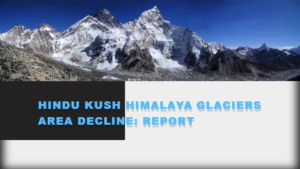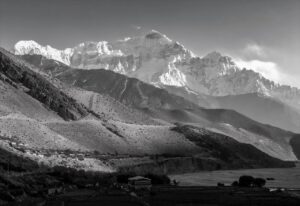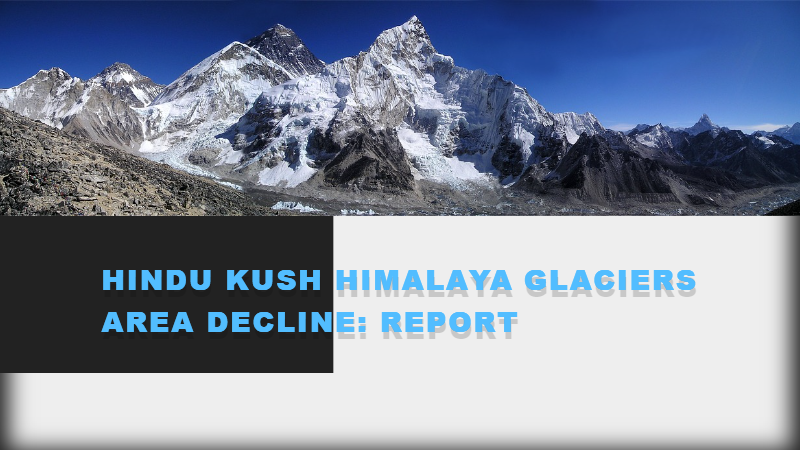HINDU KUSH HIMALAYA GLACIERS AREA DECLINE IN REPORT

The International Centre for Integrated Mountain Development (ICIMOD) released Water, Ice, Society, and Ecosystems (WISE) report for the Hindu Kush Glacier.

The WISE report highlighted the following impacts climate change on Hindu Kush Himalaya:
o Glacier: Water Glaciers disappeared 65% faster in the 2010s than in the previous decade.
✓ For global warming between 1.5°C to 2°C, by 2100 glaciers are set to lose 30%–50% of their volume compared with 2015.
o Water Security: With accelerated glacier melt, ‘peak water’ will be reached around mid-century in most Hindu Kush Himalaya river basins, and overall water availability is expected to decrease by the end of the century.
✓ Peak water is a stage in which the supply of fresh snow water due to glacier melt will be the highest ever.
o Increase in Hazards: Hazards like floods, and landslides, large avalanches, glacial lake outburst floods (GLOFs) etc. are projected to increase over the coming decades.
✓ A three-fold increase in GLOF risk across the Hindu Kush Himalaya is projected by the end of the twenty-first century.
About The International Centre for Integrated Mountain Development (ICIMOD)
ICIMOD is an intergovernmental knowledge and development organization (established in 1983) that focuses on climate and environmental risks, green economies, and sustainable action.
o Afghanistan, Bangladesh, Bhutan, China, India, Myanmar, Nepal, and Pakistan are its members.
About Hindu Kush Himalaya (HKH)
About HKH
► Stretches 3,500km from Afghanistan to Myanmar. ► Has the highest mountain ranges in the world and the largest volume of ice on Earth outside the polar regions.
> The region is also known as the ‘Water Towers of Asia’.
Significance of Hindu Kush Himalaya (HKH)
- Feeds major Rivers Ganges, Indus, Irrawaddy, etc.
- Regulates global climate system as the snow cover cools the atmosphere by reflecting sunlight.
- Provides economic opportunities through recreational activities.
- Cultural and spiritual importance, for example Gangotri glacier.
- Cryosphere components including permafrost and glacial lakes provide various ecosystem services.
Challenges in tackling the deteriorating situation in HKH
- Poor adaptation capabilities: There are large gaps between the adaptation needs of communities and their access to the necessary adaptation support due to less financial and technical support.
- Complex and unpredictable Hazards: Early warning and adaptation measures are difficult to implement as several different slow- onset hazards (like erosion) and fast-onset hazards (like GLOFs) are occurring in the same watersheds frequently at same time.
- Population growth and infrastructure development: It has exposed larger communities to increased hazards.
- Low protection: About 67% of ecoregions and 39% of global biodiversity hotspots that are in the HKH are still outside protected areas.
- Limited Regional Cooperation: HKH is spread over multiple countries leading to issues in data collection and implementing uniform policies.
- Neglect at International Forums: HKH’s concerns are not given due priority in the international climate discussion such as the United Nations Framework Convention on Climate Change’s (UNFCCC’s) Conference of Parties.
Steps Taken to protect Glacial Ecosystem India’s Initiatives
- National Mission for Sustaining the Himalayan Ecosystem (NMSHE) is implemented by the Department of Science and Technology.
o It is part of the National Action Plan on Climate Change (NAPCC), launched in 2008.
- National Centre for Polar and Ocean Research (NCPOR) established by the Ministry of Earth Sciences
(MoES).
- Research station ‘Himansh’ was established in the Chandra basin (Himachal Pradesh) in 2016.
- National Institute of Hydrology (NIH) is conducting several studies for the assessment of runoff from the melting of glaciers at catchment and basin scales.
Global Initiatives
- ICIMOD’s initiatives like Hindu Kush Himalayan Monitoring and Assessment Programme (HIMAP), Mountain Ministerial Summit, etc.
- Framework for regional cooperation by United Nations Development Programme (UNDP) and ICIMOD.
- UNESCO’s World Glacier Monitoring Services.
Way Forward
- Regional and global cooperation are needed for
o technical and financial assistance to facilitate adaptation and mitigation,
o enhancing transboundary data and information sharing and
o effectively protecting mountain communities and biodiversity hotspots.
- Improve monitoring Network: Techniques such as in-situ measurements, remote sensing, satellite data, and modelling can be combined to generate high-quality products.
- Building adaptation and early warning strategies taking into account the increased likelihood of multi-hazards and cascading events due to climate change.
- Adopting Integrated Water Resources Management Approach: Governments should thoroughly understand water sources’ contribution to river flows to anticipate future changes.
- Stakeholder engagement and communication: Raising awareness among stakeholders (including mountain communities, civil society, private sector, governments, etc.) about the ongoing changes and preparation needed for tackling them.
Read about: ‘take-make-dispose’ to Circular Economy model
